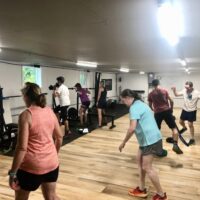One of my proudest moments as a coach is not a race victory, a team score, or an award.
Earlier this summer at a regional camp, another coach stood next to me when dividing up groups. They leaned over and said “I want to collaborate on your station, because the MNC juniors all classic ski really well and I want to start figuring out why and how.”
Many of us start out on classic skis, be it step-in skis as youngsters or waxless skis as an introduction to the sport. In some respects, that’s the easiest form of skiing there is. Want to get out on snow with someone that’s never touched skis before? It’s likely you aren’t going to jump onto skate boards.
Yet mastering classic skiing with kickwax or klister, on narrow race skis and with speed in mind, is far from easy. Classic skiing perfectly embodies that phrase “easy to learn/hard to master” due to its complexity and necessary balance of power/speed/technique/tempo/body awareness.

If you are a racer, chances are about 50% of your competitions will be classic style. It is necessary to be proficient in both techniques, and yet often teams and coaches, especially at the HS/Junior level, will opt for skate far more frequently. When you have a large team, or a group that needs to eat into training time just to get on snow (for example, taking a bus to Sleepy Hollow) this is understandable and a logical factor of planning for these teams.
Teams and coaches will also take conditions into account. If wax looks tricky, or klister is involved, a switch to skate makes life easier.
But it isn’t always about making things easy! To that end, we tend to commit to classic a lot, likely a bit more than skating, especially in the early season. Through analysis of training logs over the years, in which we track time spent in each technique, it’s clear that a huge step is made when two things happen:
- An increase in strength training, when the developmental window is correct to involve this type of training
- A more even balance of skate and classic skiing
Classic with our group can be tough…I often spend the first 45 minutes of a session just dialing-in wax, helping apply klister or a klister/hardwax combo, or making adjustments to skis while everyone gets warmed up. But is this really too different from a race day? Nope! And our willingness to classic ski in tough conditions pays dividends in the winter because, guess what? We’re rarely racing in nice hardwax classic conditions!
This year more than ever I have been super impressed with the level of classic skiing in our group. What is it attributed to? CONSISTENCY, more than anything else. We make the effort to classic ski, and we learn by simply putting in the time. Other little things include:
- Consistent strength training that helps build good body position, stability, and power
- Intervals on repeated loops, but at different speeds and efforts to feel smooth vs fast vs hard
- Switching some of our rollerski ratchets to the front wheel, making it harder to kick during dryland
- Doing drills where we ski on wet soapy leaves to practice slipping, or doing rollerskiing/skiing on grass
- Watching video of top athletes, and video of ourselves, frequently!
To that end, here are some clips of early-season classic skiing from a collection of our skiers:
Even if the snow is less-than-ideal, my challenge to anyone looking to improve their classic skiing is to take a chance and put yourself in some tricky conditions. Work on the technique when it is hard, not just easy, and you’ll be rewarded with improvement and a more well-rounded arsenal of technical abilities!




Comments are closed.